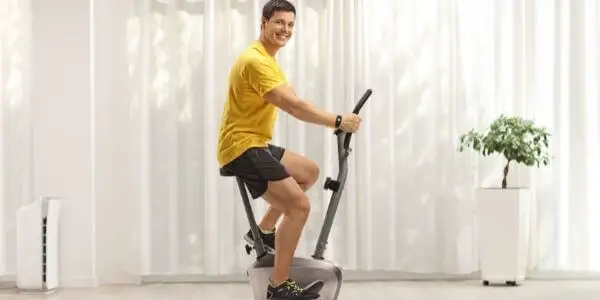Exercise bikes have a slew of health benefits, and obviously, they activate your legs. But will your lower body become objectively stronger from using a stationary bike?
A common myth in the fitness world claims that excessive cardio weakens your muscles.
Do exercise bikes strengthen legs or not? Read along as we explore the science behind that question.
Table of Contents
Will Stationary Bike Make Legs Stronger?
Using a stationary bike will strengthen your legs if:
- You’re using a resistance that challenges you personally.
- Your workouts are long enough to challenge you.
- You keep improving your stats over time.
That’s why you have to consider your current situation and your fitness goals before choosing a stationary bike. First, there are four types of exercise bikes:
- Recumbent
- Upright
- Spin
- Assault
Next, each category has different products that cater to an array of needs.
Let’s take two examples.
First-case scenario, you’re a sedentary person with some joint pain. You’re looking to increase leg strength but don’t have bodybuilding aspirations. In this situation, you can consider:
- An upright bike with a 7-10kg flywheel
- A recumbent bike, if you also have chronic back pain
Second-case scenario, you’re a generally active, young person with no mobility issues. Your goal is to have beautifully sculpted legs. In this situation, you can choose:
- A spin bike with a heavier flywheel that allows you to combine HIIT and strength routines
- An assault bike that allows you to create more resistance as you’re pedalling faster. This option is best if you’re also looking to lose weight and don’t have any heart-related conditions
But muscles alone don’t make your legs stronger. You also need your bones to do their part.

So, what does the science say about exercise bikes’ effect on bone density?
As you know, a sedentary lifestyle, age, and endocrine disorders can lead to significant losses in bone density. As a result, your bones become frail.
One study points out that riding a road bike doesn’t do anything for your bones’ density. The authors say that’s probably because participants sit down for long periods and then lie down for other extended periods to recover.
So, if you want to improve bone strength choose a stationary bike that:
- Allows an upright position (spin bikes, some upright bikes, some assault bikes)
- Has enough resistance to challenge you
On the other hand, if you’re mobility challenged and can’t use these bikes:
- Choose a recumbent bike because studies show they can improve knee pain and range of motion.
- Try low-impact weight-bearing exercises that your doctor approves, such as walking or raining on the elliptical.
For more info on how to choose the right stationary bike for your needs, read this article.
Can You Build Leg Muscles on an Exercise Bike?

Yes, you can build leg muscles on an exercise bike, but:
- You have to use a higher resistance. Be mindful, though; increase your bike’s resistance to something that challenges you, not something that challenges The Rock.
- You have to choose the right bike for your needs:
- Recumbent bikes are best for mobility-challenged people and beginners. They primarily target your quads and hamstrings.
- Assault bikes are best for HIIT and 2-in-1 strength-and-cardio intervals. Purchase one if you’re a beginner, but want to become a pro.
- Upright bikes are best for beginners who want to become upper intermediates at most. If you’re going to increase your lower leg muscle mass, choose a heavy-flywheel upright bike. Also, make sure your chosen bike has enough built-in programs that combine HIIT and strength.
- Spin bikes are best for intermediates who want to become advanced. These bikes are perfect for their unique blend of HIIT, strength, and exercise versatility. For example, standing upright on a spin bike works your calves and glutes more. When you’re sitting, your quads have to work harder.
If you want to improve muscle gain:
- Use HIIT. Pedalling fast at high intensity for your entire workout weakens your muscles fast, and you won’t be able to keep it up for long. Besides, several studies prove that High-Intensity Interval Training considerably improves people’s body composition. Thus:
- Choose a stationary bike with various incorporated HIIT workouts or Bluetooth connectivity to try different online exercises.
- Set your own HIIT routine. Pedal at high resistance for 45 seconds, followed by 15 seconds of medium-low intensity. Repeat for 15-20 minutes.
- Vary your positions. You can target specific lower leg muscles, but you have to choose a stationary bike that allows you to change stances. Spin bikes are the most versatile, but some upright bikes also allow different postures. For example:
- Hovering employs your quadriceps because lifting your butt from the seat puts more pressure on your quads
- Pedaling upright engages your calves and buttocks more
- Pedalling backwards activates your hamstrings and hip muscles
- Combine cardio and strength training. A study in PLOS ONE cited by Men’s Health shows that lifting plus cardio increases your muscle mass more than simply strength training. The most probable explanation is that cardio activates type I endurance muscle fibers. By comparison, strength training only switches on type II fibers. But together, these different workout strategies employ more muscle fibers.
Can Exercise Bike Tone Legs?

Up till now, we proved that exercise bikes can increase your lower body strength and muscle mass. What about toning your legs?
An essential factor in shaping your legs is decreasing the fatty tissue around your leg muscles. That means you have to:
- Burn sufficient calories
- Increase muscle mass
- Accelerate your metabolism
So, choose a high enough resistance to challenge you and opt for HIIT instead of steady-state cardio. For maximum fat loss, you should do both cardio and strength training.
How Long Does It Take to Tone Legs on Exercise Bike?
It will take about four weeks to see results in your body shape. Your family and friends will notice your results in 6-8 weeks, while acquaintances need 10-12 weeks to see your progress.
However, you have to:
- Challenge yourself with every workout. Increase your bike’s resistance and speed according to your new fitness level. Aim to progress a little every week.
- Give yourself enough breaks for your body to recover. Ideally, you can use your exercise bike 3-4 times per week in 30-60-minute sessions.
- Eat healthily. Eliminate saturated fat and empty carbs from your diet. Instead, eat healthy fibers that reduce water weight, lean protein to promote muscle growth, and healthy fats that increase your body’s fat-burning engines.
- Stay active throughout the day. Use your improved endurance and strength to hike, swim, or play with your kids. 60 minutes of pedaling isn’t enough if you’re a couch potato the rest of the day.
In Conclusion – Before and After
Many discuss exercise bikes before and after results too. Most agree that using an exercise bike improves your lower body endurance and strength quickly, but it takes more to see increased muscle mass. However, years of pedaling leave expert cyclists with proportionally larger lower bodies.
As you can see, you have to choose the right bike and workout style for your goals.
Some people want to slim down and tone their legs. Others want to increase their leg muscle mass without shedding a pound.
So, choose a stationary bike that fulfills your needs from the get-go.
- How To Avoid Weight Loss Plateaus - July 9, 2024
- 5 Common Weight Loss Mistakes - July 9, 2024
- Walking vs Running: Weight Loss, Fat Loss, Life Span AND MORE - July 9, 2024

